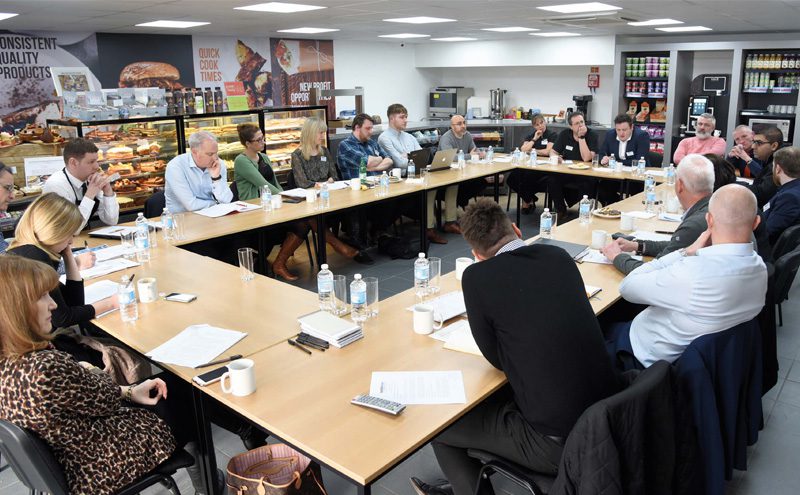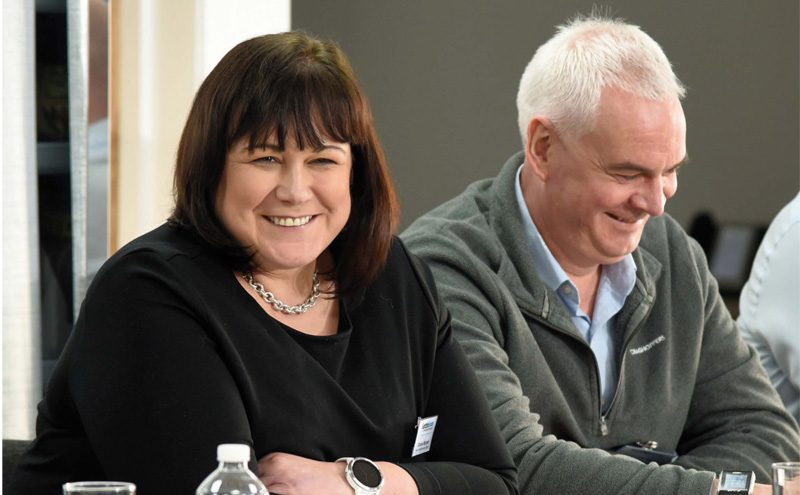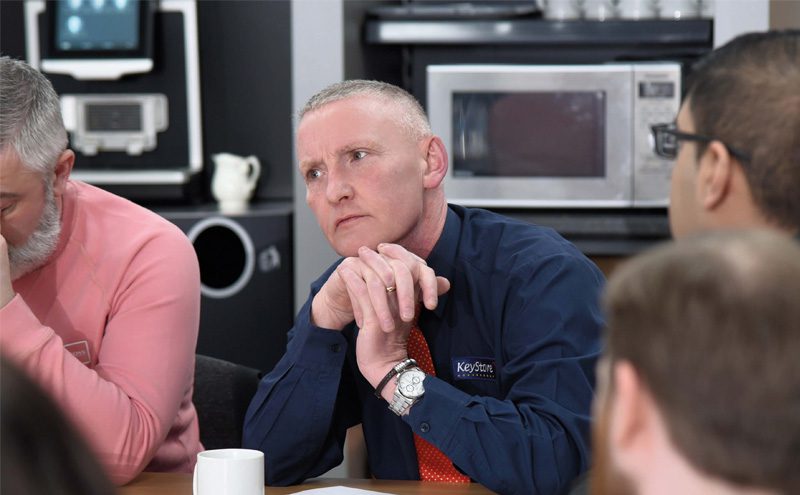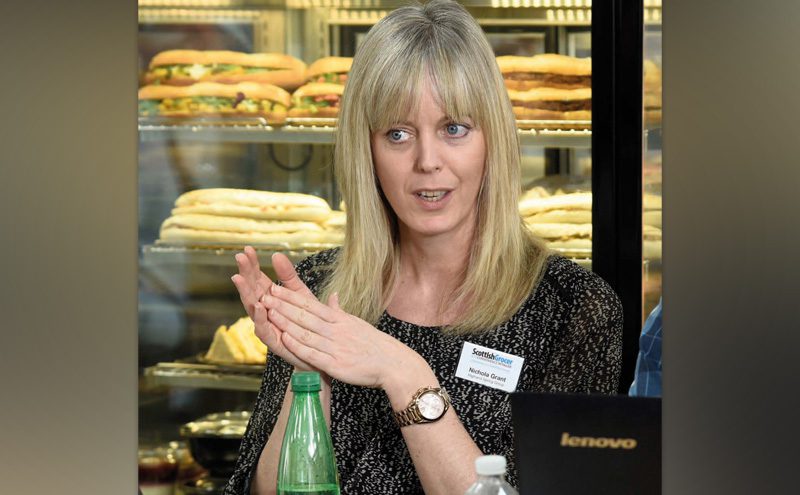In the first Convenience Conversation of 2019, Scottish Grocer invited a group of retailers, suppliers and EPOS firms to Kirkcaldy to talk food to go and impulse. Discussion centred around how c-stores can position themselves to make the most of this valuable market

HERALDED by some as a potential saviour of convenience stores, food to go continues to be one of the most talked about issues in Scottish retail.
It was fitting then that retailers and suppliers gathered together for the first Scottish Grocer Convenience Conversation event of 2019 at Fife Creamery’s training centre in Kirkcaldy – where maximising the potential of food to go and impulse was top of the agenda.
Brand representatives at the round-table discussion included Mark Carlton and James Harper from AG Barr, Gordon McSkimming from Coca-Cola European Partners, Nichola Grant from Highland Spring, Jemma Healy from Lucozade Ribena Suntory, James Loker and Luke Sismore from The Retail Data Partnership and Graeme Renton and Steve Appolinari from Fife Creamery.
They were joined by retailers Zahid Mukhtar of Nisa Kirkcaldy, Diane Greenough of David’s Kitchen Falkirk, Keith Fernie of David’s Kitchen Glenrothes, Bruce and Donna Morgan of Best-one @ Brownlies in Biggar, Dan Brown of Pinkie Farm Musselburgh, Wilson Rea of Keystore Lanark, Faraz Iqbal of Premier Linktown Local and Scott Graham of McLeish’s Inverurie.
Scottish Grocer editor Matthew Lynas – who chaired the discussion – kicked things off by asking the retailers present to explain how they got started on the their food to journey, and what obstacles they found along the way.

• Donna Morgan of Best-one @ Brownlies in Biggar, said that her food to go journey started around six years ago by “doing a few rolls.”
That has since grown into an offering that includes hot food from six in the morning through to late afternoon, with rolls and baguettes filled by the team in store.
Donna admitted she would like to do more food to go, but with space restricted in the store she said she didn’t know what she would take away to make room.
Her husband Bruce agreed. “It would need quite a major investment to do something like a deli counter,” he said, “and you ask yourself, do I take the plunge?”
One way that the duo have managed to cut costs in their fresh food operation is by replacing their storeroom chillers with more energy efficient versions, which Bruce engineered himself.
“Our energy bill has fallen significantly,” said Donna. “It’s not all about looking at what you are doing in the front, it’s about looking at what kit you have in the back to reduce your costs. I think we are saving between £5-6000 a year by looking at our energy costs.”

• Fife Creamery sales director Steve Appolinari admitted that many retailers were “frightened” by the number of hurdles – from hygiene certification to sourcing equipment – that face retailers as they embark on their food to go journey.
“That’s where companies like us need to get that message across,” he said. “What suits one person doesn’t suit the next – you help them find what is right for them.”
James Loker, of The Retail Data Partnership, agreed that small steps were needed for those starting off in food to go.
“Food to go is one thing that quite a lot of shops will use as a last-ditch effort if they are in trouble. We tend to suggest incremental steps.
“Rather than building a kitchen, we will say to them ‘are you doing a meal deal? No? Right, that’s where we need to start.’
“You’ve got chiller space, open up some sandwich space and set up some meal deals and build up from there.
“If you say to someone who is in trouble already to spend £100,000 on a kitchen – which might work and might not – then that doesn’t make sense.”
And despite having a well-established food to go model and an in-house kitchen, Diane Greenough, of David’s Kitchen Falkirk, agreed that simple methods were the key to success.

“Whenever we try something different, we always try the easiest possible, quickest way for us. It is labour intensive, so the easiest route is always the best. If it is something that is already made up, fantastic.”
Dan Brown, of Pinkie Farm Convenience Store in Musselburgh, also recommended starting at a basic level and then working up.
“Catering equipment is very expensive, so it might be worth looking at getting it second hand, there is a lot out there that is available.
“Don’t jump into anything too big straight away.”
People are willing to pay for quality. It’s nothing to do with price. You are robbing yourself if you get a cheap product in and you spend your time putting it out there. It might be a harder sale initially, but as soon as people have the confidence in you they come back. –Keith Fernie, David’s Kitchen, Glenrothes
• While the wisdom is to start small in food to go, retailers were also keen to stress that should not mean foregoing quality.
Keith Fernie, of David’s Kitchen Glenrothes, said he had found that people were willing to pay for quality products.
“It’s nothing to do with price. You are robbing yourself if you get a cheap product in and spend your time putting it out there.
“We are all human. If you buy a sandwich or a roll and it is cheap and rubbish, would you go back and buy another one? No.
“You need to have a quality product and take the money from it. It might be a bit of a harder sale initially, but as soon as people have the confidence in you then that is when they come back.”

Wilson Rea, of Keystore More Lanark, said that his findings were exactly the same.
“I buy frozen sausage rolls through Nisa, English sausage rolls, equivalent to Greggs. And I also get my local butcher to make sausage rolls,” he said.
“The ones I buy from Nisa I retail at £1.69, on a buy one get one free. The ones from the local butcher I retail at £1.89.
“And I am still selling more of the local butcher ones. It is all about quality.”
• Selling fresh products may lead to wastage, but Keith was keen to stress that retailers should view that as a necessary part of success.
“Our wastage runs between 1%-1.4%, but the biggest percentage of that is food to go. It’s a psychological thing for retailers to be writing stuff off, but you can’t be thinking the same way for food to go.
“You might be writing off a sandwich at £2.99 but it hasn’t cost you that. The sandwich that you are going to throw in the bin has probably cost you 80p, but you are selling it for £2.99.
With things like meal deals, I think it is down to the suppliers to support the retailers in point of sale, to make the customer aware we have link up options.
–Mark Carlton, AG Barr
“You can’t think of the retail price that you are throwing away, but the cost price.”
And for Scott Graham, of McLeish’s Inverurie, costs were reduced by looking across the store and maximising the uses of each product.
“It is simple. You buy tuna mayonnaise: that makes bread sandwiches, a roll, a wrap or a tuna salad box.
“You then add peppers to it and that makes tuna crunch: you now have a tuna crunch roll, wrap or salad box. You then add sweetcorn to it and you have tuna sweetcorn.
“Before you know it you have 15 lines out of one box of tuna.
“I would also suggest using your shop wastage as part of your food to go. If you have rolls on the shelf that are going out of date tomorrow, use those as part of your food to go. Same goes for cold meats, cheeses.”
Graeme Renton from Fife Creamery agreed, saying that some of his suppliers were now describing sandwich fillers as “a full day meal solution.”
“When you open that tub, think about how you can use it all day today, and tomorrow,” he advised.

• Food to go undoubtedly has many benefits, but to extract the most from the category retailers were in agreement that getting staff on board is key.
Gordon McSkimming, of Coca-Cola European Partners, further stressed the importance of staff when looking to generating link sales through food to go.
“If you do buy a sausage roll, how often does the member of staff say to you – ‘do you want a drink with that?’ To try and get the upselling opportunity?”
The opportunity to generate incremental sales for soft drinks through food to go was recognised by all brands in attendance, and AG Barr’s Mark Carlton admitted that this is an area where brands could potentially do even more to help c-stores.
“With things like meal deals, I think it is down to some of the suppliers to support the retailers in point of sale, to make the customer aware that we have link up options,” he said.
The importance of effective point of sale was highlighted by Highland Spring’s Nichola Grant, who said that consumers spend an average of just 50 seconds choosing a meal deal and an even shorter time picking their soft drink.
To try and keep these consumers engaged, Jemma Healy of Lucozade Ribena Suntory recommended rotating soft drinks in the chiller.
“I think keeping it simple is really important,” she said.
“Having your core is important in each segment – whether it is energy, water or others – and then you allow one or two spaces in each of these segments for NPD or seasonal trends. Just keep it rotational.”

• Jemma also advocated catering to both energy and health-driven shopper missions, giving consumers a choice but ensuring “you stay where your sales are.”
The importance of choice was emphasised by Scott Graham of McLeish’s Inverurie, who said that retailers’ role was to give options to consumers.
“If they want full fat coke, they can buy one, if they want diet versions, they can buy one,” he said.
“That is what it comes down to. Our meal deal has an option for Walkers crisps, but you can swap that for a piece of fruit.”
The significance of consumer choice became apparent to Zahid Mukhtar, of Nisa Kirkcaldy, when he refitted his Ballingry store in 2012.
“I got a grant for £2,000 from the Scottish Government for having a healthy counter at the front of the store,” he said.
“The criteria was that it all had to be healthy options, no fizzy drinks.
“We did the refit, but for the first six months the wastage was so high that I phoned them up and offered to give them the money back.
“They said, ‘Its fine, just do what you want to do.’ We introduced energy drinks and fizzy drinks into the food to go, and it worked much better.”

• With thoughts turning to the Scottish Government, Scottish Grocer editor Matthew Lynas asked how people were approaching the issue of plastic waste and a potential deposit return scheme.
Nichola Grant explained that while Highland Spring had recently rolled out its 100% rPET Eco Bottle, consumers still lacked some environmental awareness.
“If we are going to be doing rPET, we need that plastic back in the system, so people have to get involved with the whole continuous loop of plastic.
“It is going to take a bit of time, us talking about recycling, helping educate you so you know what to stock, and also trying to get consumers to do the right thing.
“It will come, but this is about a huge shift in consumer behaviour.”
Dan Brown, of Pinkie Farm, admitted that he had not been “necessarily supportive” of DRS when the Scottish Governmet first announced its intentions.
But, Brown reckons that trials carried out by c-store retailers have shown an uplift and a high level of redemption with DRS coupons.

Wilson Rea said that he had started a bottle return scheme in his Lanark store, and that it was “working a treat.”
“About six months ago I started selling glass bottles for milk: customers then bring them back empty and get 10p.
“It is definitely driving footfall, there is no one else selling these glass bottles,” he said.
• Talk of legislation inevitably then turned to the Scottish Government’s plans to restrict retail promotions, as well as proposals for increased regulations on labelling ingredients in food to go.
The biggest worry is that the government is going to make food to go more difficult with portion control. I would then stop making it in store.
– Scott Graham, McLeish’s Inverurie
Some of the suggested measures include reducing portion sizes, applying maximum calorie limits and making calorie labelling mandatory on all food sold out of home.
Scott Graham, of McLeish’s Inverurie, warned that the legislation on ingredients and labelling could force him to give up making his own food to go.
“I get why we need to list the ingredients, but if they are going to ask me to do a complete breakdown…
“I carry about 60 sandwich lines. You would have to send all 60 to a lab, at £80 a time, to get a nutritional breakdown of everything in each product.
“I would then stop making it in store and buy it in, going from a 130% margin on a sandwich to about 30%.”
Dan Brown shared concerns about additional legislation governing food to go, suggesting it may deter retailers from entering the category.
“It is creating a barrier for any retailer who wants to try it, as well as taking away from those who are currently doing it.
“Food to go seems to be one of the last lifelines for a lot of businesses.”
And for Keith Fernie of David’s Kitchen, additional legislation was not likely to result in a change in consumer purchasing habits.
“Tax doesn’t change people’s behaviour, the sugar tax has taught us that. People will pay the extra,” he said.


















